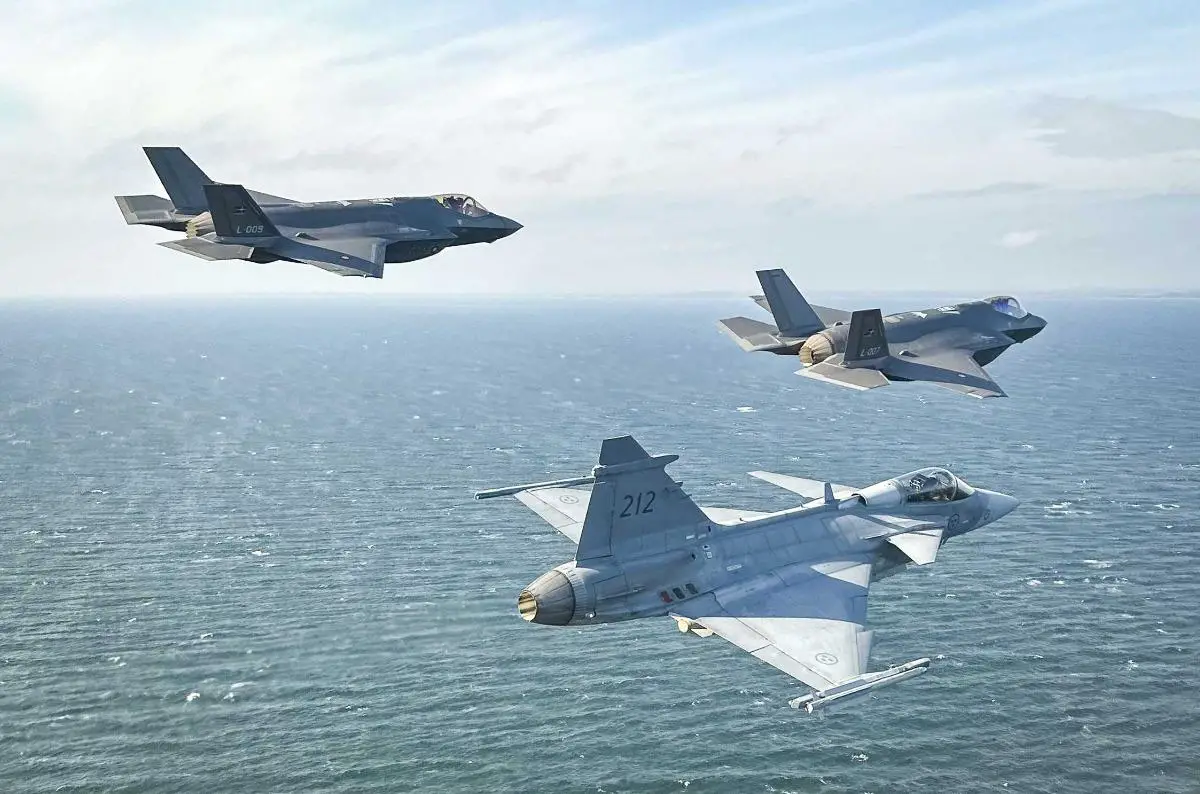For the first time as NATO Allies, Danish F-35 and Swedish JAS-39 Gripen fighter jets flew aerial combat training drills in and around Danish airspace on March 11 and 13. The training missions showcased the close military cooperation between the Danish and Swedish air forces and also demonstrated efforts to integrate and interaction of different fighter jet generations across the Nordic countries. The drills were primarily conducted in separated training areas over the Kattegat waters. They consisted of one-to-one fighter manoeuvres and coordinated flying of Danish F-35s from Fighter Wing Skrydstrup and two JAS-39 Gripen from ‘Blekinge Flygflottilj’ at Ronneby near Karlskrona in southern Sweden. The cooperation is based on a mutual interest in the two nations across the Øresund making use of experience and competences in order to strengthen combined air warfare power. The training exercises involving the Swedish-produced JAS-39 and the American-produced F-35 underline the need to ensure existing and new combat aircraft fleets must be able to cooperate and interact on the modern battlefield.

“Carrying out this type of exercise flying with another type of aircraft provides different challenges and experiences than when it is normally practiced against our own units. The cooperation with the Danish pilots has been very easy and uncomplicated. The biggest challenge has been whether to speak English or Danish/Swedish on the phone during briefing and debriefing. This week’s exercises were the beginning of increased cooperation where the proximity to the divisions at Skrydstrup and the simplicity of cooperation provide good conditions for us to develop and strengthen our ability to fight together as a ‘Nordic Air Force’,” said Lieutenant Colonel Erik Almquist, Commanding Officer 172 Fighter Squadron of the Swedish Air Force.
Being neighbours and close allies, utilising each other’s capabilities not only provides great training value for pilots and personnel, but it is also visible proof of the ambition to be able to operate effectively together”, says Air Force Chief Major General Jan Dam.

“We met our Swedish colleagues in Danish airspace to fly Basic Fighter Manoeuvres (BFM), also known as 1 versus 1 air combat training. Most often we fly BFM against our fellow F-35 pilots. The Gripen and Swedish pilots fly differently, so a 1 versus 1 match against them is a professional challenge. We get to test elements of our own tactics that we don’t normally do. It is awesome! And of course it’s great to meet the Swedes in Denmark,” says TRI, one of the Danish F-35 pilots from Fighter Wing Skrydstrup in Southern Jutland.
“The Gripen and the F-35 belong to two different generations of combat aircraft, and they therefore have different characteristics to be able to contribute to the battlefield. As a 5th generation combat aircraft, the F-35 has a special ability to collect and process massive amounts of data, which it can subsequently share with other allies and actors”, explains Lieutenant Colonel Casper Børge Nielsen, head of the Air Command’s Combat Flight Department.

The integration between the F-35 and the Gripen enhances the combined operational capabilities, because the F-35 is able to generate and share an unprecedented situational picture, from which the Gripen can also benefit. Conversely, the Gripen represents an advanced fighter aircraft that brings additional firepower to the fight. It will benefit both fifth and fourth generation fighter aircraft and, in a broader perspective, it will give land and naval forces the opportunity to operate more freely and efficiently. It creates different requirements and challenges when training against an unfamiliar adversary. In the autumn of 2023, Denmark received the first four F-35 combat aircraft on Danish soil, while six aircraft are still located in the USA for training flights. In total, Denmark has invested in 27 F-35 combat aircraft, of which the remaining 17 are planned to be delivered within the coming years.
















